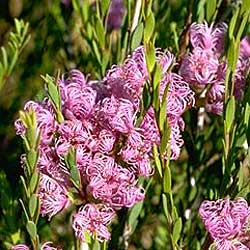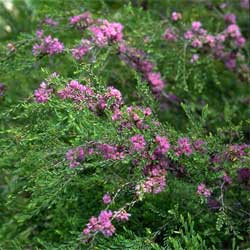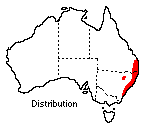Melaleuca thymifolia
 |
 |
Thyme-leaf Honey-myrtle
From the many small Melaleucas of garden value, Melaleuca thymifolia (Thyme-leaf Honey-myrtle) is chosen for its frequent flowers and general adaptability for a small garden or public park. It comes from New South Wales and Queensland, growing in mild, moist areas and light soils, but has not needed protection from frost in the Australian National Botanic Gardens and has survived droughts. In extreme cold exposed plants can look chilled.
 Watered shrubs are luxuriant and full of long, straight tip growths. Really
heavy watering or high rainfall brings beautiful large, soft flowers in profusion,
but plants may droop, revealing tough papery branches. The branches recover,
however, by curving inwards again and pruning is seldom necessary to keep a
shapely plant.
Watered shrubs are luxuriant and full of long, straight tip growths. Really
heavy watering or high rainfall brings beautiful large, soft flowers in profusion,
but plants may droop, revealing tough papery branches. The branches recover,
however, by curving inwards again and pruning is seldom necessary to keep a
shapely plant.
In the Australian National Botanic Gardens, plants of this species have reached over 1.5 m high in a very enclosed position among taller shrubs. Others, in light soil and well watered have become ground covers 3 m across and under 1 m high in10 years. Some of a similar age are nearly flat-topped, or irregular small shrubs under 1 m. Specimens in drier conditions in full sun, have become compact 1m high shrubs at 10 years old, tending to develop short trunks. Growth is in tufts of thin stems towards the branch ends and the bare wood has many clusters of old seed capsules.
It is long-lived and recovers well from drought and other setbacks, though exposure to strong winds can cause a permanent lean, or plants may even be dislodged. It is useful in a rockery, in group plantings, or for extensive ground covers lightly trimmed. Wet soil conditions are no bar to this plant.
Specimens taken from several wild origins show interesting variations in shape and size and indicate that environment plays an important part in shaping the plant. Several cultivars have been named from this species, including M thymifolia 'Pink Lace' and M. thymifolia 'White Lace'. M. thymifolia 'Little Beauty' is a compact, low-growing form.
The plant has delicate reddish young stems and blue-green foliage, both spicily aromatic when bruised. The simple leaves are about 1 cm long in even pairs pointing upwards close to the stems. On ripe wood, below the new tips, are small clusters of stemless flowers, rich mauve in spring and summer and bluish-purple in early winter in Canberra. They are the 'claw' type of flower in which the stamens are joined lower down and free towards the tips where they curve inwards. They are like five-feathered petals of firm substance.
Flowers often open eight months of the year, freely around late November and then slowly till autumn when another flush occurs. After this flowers open unevenly depending on the weather and finally cease towards mid-winter, full of buds for next spring.
Propagation is not difficult and the species is generally obtainable from nurseries dealing in native plants. Seed can be collected by taking mature capsules and keeping them indoors to open in a bag, or cuttings may be taken from the plentiful tip growths in December or January.
This charming shrub seems to thrive in any soil with little attention besides trimming, and is usually free from pests and diseases.
Text by ANBG staff (1974)
Name meaning: Melaleuca thymifoliaMelaleuca - from two Greek words, melas, black, and leukos, white, as the first Melaleuca discovered had white branches but a black trunk, possibly from fire. Another opinion contrasts the white bark with the very dark foliage of some species; thymifolia - thyme-leaved, a name sometimes given to plants with
this type of similar leaf
|
![An Australian Government Initiative [logo]](/images/austgovt_brown_90px.gif)

